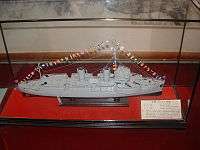SS Zhongshan
The SS Zhongshan,[1] formerly romanized as Chung Shan,[2][3] was a Chinese coastal defense ship of 780 tons. Built in Japan in 1913, it was originally known as the SS Yongfeng[4] (romanized at the time as Yung Feng[5] or Wong Feng)[6] before being renamed in 1925 in honor of Sun Yat-sen, better known in China as Sun Zhongshan. This ship and others of its class are frequently classified as gunboats.
Construction
The SS Yongfeng was the first of four 780-ton Yongfeng-class coastal defense ships ordered from Mitsubishi by the Qing Empire in 1910.[7] Under the deal signed between the Qing naval minister Zaixun, his deputy admiral Sa Zhenbing, and the Japanese, the first two ships were built in Japan and the second pair at Jiangnan Shipyard in China with Japanese technical help. All four ships differed slightly from one another. Due to their small size (less than 1000 tons displacement), these ships are also frequently referred as gunboats.

Service
The Yongfeng entered service as part of the Beiyang Fleet.[8] In March 1913, it sailed to Shanghai, where it was based at Yuezhou.[9]
It sailed south with Sun Yat-sen in July 1917,[8][9] subsequently forming part of the Nationalist navy at Guangzhou (then "Canton").
Just prior to Ye Ju's assault of the presidential palace on 16 June 1922, Sun Yat-sen fled to the Guangzhou naval yard[5] and took refuge aboard the SS Haiqi (then "Hai Ch‘i"), a cruiser. From there, he transferred to the gunboat SS Yongfeng,[10] where he was joined by Chiang Kai-shek around the 27th[5] or 29th.[11] The Yongfeng and other loyal ships then fought past Pearl River fortresses controlled by Chen Jiongming[12] while launching assaults and negotiating with the Guangzhou leadership for about 50 days.[8] It avoided reprisals by anchoring off Huangpu, surrounded by foreign vessels Chen could not risk firing upon.[5] Finally, Sun and Chiang left aboard a British ship to Hong Kong on 9 August,[11] whence they departed for Shanghai.[8] The Yongfeng carried Sun and his wife to Hong Kong in November 1924.[9]
On April 13, 1925, the ship was renamed in honor of Sun Yat-sen,[9] better known in China as "Sun Zhongshan", following his death the previous month.
In November 1925, the Nationalist navy was placed under the direction of the Soviet adviser Andrei S. Bubnov, who named the Communist Li Zhilong as its head.[13] The voyage of the Zhongshan and Baobi from Guangzhou to Huangpu ("Whampoa") on 18 March 1926 set off the "Canton Coup".[13]
She patrolled the southern coasts of China against pirates after the Northern Expedition. She rescued the Xinhua (Hsin Wah) in 1928.[14]
In the Second Sino-Japanese War, the Chinese theater of World War II, SS Zhongshan participated in the Battle of Wuhan. She was bombed and sunk in the Yangtze River by the Japanese on 24 October 1938 with 25 casualties.
Recovery
Hubei's provincial cultural department received permission to plan the recovery of the Zhongshan in 1986.[9] The shipwreck was finally salvaged from the Yangtze on 28 January 1997.[9] By 2001, it was restored to its appearance c. 1925, except for some of the damage which sank the ship in 1938.[9]The salvaged and restored Zhong Shan gunboat is now located in its own museum in Wuhan. It was China's first floating museum.[9] The museum is located in Jinkou Subdistrict of Wuhan's suburban Jiangxia District,[15] some 25 km southwest of downtown Wuchang. In 2003, relics from the ship were also displayed at Hong Kong's Museum of Coastal Defense.[9]
Gallery

 The restored Zhongshan inside the museum
The restored Zhongshan inside the museum The hole that sank the ship
The hole that sank the ship
See also
- Sun Yat-sen, an American Liberty ship
References
Citations
- ↑ Mackerras, Colin; et al. (1991), The Cambridge Handbook of Contemporary China, Cambridge: Cambridge University Press, p. 7.
- ↑ Li Chien-nung (1956), Teng, Ssu-yu; et al., eds., The Political History of China, 1840–1928, Stanford: Stanford University Press, p. 501.
- ↑ Hsu, Long-hsuen; et al. (1972), History of the Sino-Japanese War (1937–1945), Chung Wu Pub..
- ↑ Shaw, Raynor (2007), Three Gorges of the Yangtze River, Odyssey, p. 209.
- 1 2 3 4 Hahn, Emily (1955), Chiang Kai-shek: An Unauthorized Biography, p. 42.
- ↑ Wilbur, Clarence Martin; et al. (1989), Missionaries of Revolution: Soviet Advisers and Nationalist China, 1920–1927, Cambridge: Harvard University Press, p. 201.
- ↑ Chessum (2005).
- 1 2 3 4 Ships of China, Jingdao Chuban Youxian Gongsi, 1988, p. 115. (Chinese) & (English)
- 1 2 3 4 5 6 7 8 9 "Cultural relics of Zhong Shan Gunboat on Display at Museum of Coastal Defence", Press Releases, Leisure and Cultural Services Dep't of the Gov't of the Hong Kong Special Admin. Region, January 2003.
- ↑ Dreyer (1995), p. 104.
- 1 2 Biographical Dictionary of Republican China, Vol. III, "Chiang Kai-shek", p. 322.
- ↑ "Cultural Relics of Zhong Shan Gunboat on Display at Museum of Coastal Defence". Leisure and Cultural Services Department of the Government of the Hong Kong Special Administrative Region. January 2003..
- 1 2 Elleman, Bruce (2009), Moscow and the Emergence of Communist Power in China, 1925–30: The Nanchang Uprising and the Birth of the Red Army, Abingdon: Routledge, p. 24.
- ↑ "Ship Sinks off Waglan". Hong Kong Telegraph. 16 January 1929..
- ↑ "Zhongshan Warship settled in Wuhan museum". People's Daily. May 28, 2008.
Bibliography
- Dreyer, Edward L. (1995), China at War, 1901–1941, Abingdon: Routledge.
- Chessum, David (2005), "Warships for Export", Bob Henneman.
External links
| Wikimedia Commons has media related to Zhongshan Warship Museum. |
- China-Defense.com Forum > History Forum > After 1911 > The Restored ZhongShan Gunboat Photos of the Zhong Shan gunboat on display at the Museum of Coastal Defence
Coordinates: 30°20′54″N 114°7′46″E / 30.34833°N 114.12944°E
